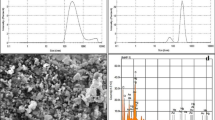Abstract
Mycobacteriosis is a type of infection caused by rapidly growing mycobacteria (RGM), which can vary from localized illness, such as skin disease, to disseminated disease. Amikacin, cefoxitin, ciprofloxacin, clarithromycin, doxycycline, imipenem and sulfamethoxazole are antimicrobial drugs chosen to treat such illnesses; however, not all patients obtain the cure. The reason why the treatment does not work for those patients is related to the fact that some clinical strains present resistance to the existing antimicrobial drugs; thereby, the research of new therapeutic approaches is extremely relevant. The coordination of antimicrobial drugs to metals is a promising alternative in the development of effective compounds against resistant microorganisms. Sulfonamides complexed with Au, Cd, Ag, Cu, and Hg have shown excellent activity against a variety of microorganisms. Considering the importance of fighting against infections associated with RGM, the objective of this study is to evaluate the antimycobacterial activity of metal complexes of sulfonamides against RGM. Complexed sulfonamides activity were individually tested and in association with trimethoprim. The minimum inhibitory concentration (MIC) and time-kill curve of compounds against the standard strains of RGM [Mycobacterium abscessus (ATCC 19977), Mycobacterium fortuitum (ATCC 6841) and Mycobacterium massiliense (ATCC 48898)] was determined. The interaction of sulfonamides with trimethoprim was defined by inhibitory concentration index fractional for each association. The results showed that sulfonamides complexed whit metals have outstanding antimicrobial activity when compared to free sulfamethoxazole, bactericidal activity and synergistic effect when combined with trimethoprim.






Similar content being viewed by others
References
Agertt VA, Marques LL, Bonez PC, Dalmolin TV, De Oliveira GNM, De Campos MMA (2013) Evaluation of antimycobacterial activity of a sulphonamide derivative. Tuberculosis 93(3):318–321. doi:10.1016/j.tube.2013.02.003
Alsaad N, van der Laan T, van Altena R, Wilting KR, van der Werf TS, Stienstra Y, Alffenaar JWC et al (2013) Trimethoprim/sulfamethoxazole susceptibility of Mycobacterium tuberculosis. Int J Antimicrob Agents 42(5):472–474. doi:10.1016/j.ijantimicag.2013.07.011
Anacona JR, Osorio I (2008) Synthesis and antibacterial activity of copper(II) complexes with sulphathiazole and cephalosporin ligands. Transit Met Chem 33(4):517–521. doi:10.1007/s11243-008-9074-y
Aung TT, Yam JKH, Lin S, Salleh SM, Givskov M, Liu S, Beuerman RW et al (2016) Biofilms of pathogenic nontuberculous mycobacteria targeted by new therapeutic approaches. Antimicrob Agents Chemother 60(1):24–35. doi:10.1128/AAC.01509-15
Brown-Elliott BA, Wallace RJ (2002) Clinical and taxonomic status of pathogenic nonpigmented or late-pigmenting rapidly growing mycobacteria. Clin Microbiol Rev 15(4):716–746. doi:10.1128/CMR.15.4.716-746.2002
Chohan ZH, Shad HA, Youssoufi MH, Hadda TB (2010) Some new biologically active metal-based sulfonamide. Eur J Med Chem 45(7):2893–2901. doi:10.1016/j.ejmech.2010.03.014
Cuenca-Estrella M (2004) Combinations of antifungal agents in therapy—What value are they? J Antimicrob Chemother 54(5):854–869. doi:10.1093/jac/dkh434
Esteban J, Martín-de-Hijas NZ, Kinnari TJ, Ayala G, Fernández-Roblas R, Gadea I (2008) Biofilm development by potentially pathogenic non-pigmented rapidly growing mycobacteria. BMC Microbiol 8:184. doi:10.1186/1471-2180-8-184
Forgacs P, Wengenack NL, Hall L, Zimmerman SK, Silverman ML, Roberts GD (2009) Tuberculosis and trimethoprim-sulfamethoxazole. Antimicrob Agents Chemother 53(11):4789–4793. doi:10.1128/AAC.01658-08
Forsman LD, Schon T, Simonsson USH, Bruchfeld J, Larsson M, Jureen P, Angeby K et al (2014) Intra- and extracellular activities of trimethoprim-sulfamethoxazole against susceptible and multidrug-resistant Mycobacterium tuberculosis. Antimicrob Agents Chemother 58(12):7557–7559. doi:10.1128/AAC.02995-14
Griffith DE, Aksamit T, Brown-Elliott BA, Catanzaro A, Daley C, Gordin F, Winthrop K et al (2007) An official ATS/IDSA statement: diagnosis, treatment, and prevention of nontuberculous mycobacterial diseases. Am J Respir Crit Care Med 175(4):367–416. doi:10.1164/rccm.200604-571ST
Houvinen P (2001) Resistance to trimethoprim-sulfametoxazole. Antimicrob Resist 32:1608–1614. doi:10.1086/320532
Marques LL (2007) Sintese, estrutura e avaliação da atividade antimicrobiana de complexos metálicos com sulfametoxazol. Thesis presented to post-graduate course in Pharmaceutical Sciences. Federal University of Santa Maria
Marques LL, de Oliveira GM, Lang ES, de Campos MMA, Gris LRS (2007) New gold(I) and silver(I) complexes of sulfamethoxazole: synthesis, X-ray structural characterization and microbiological activities of triphenylphosphine(sulfamethoxazolate-N2)gold(I) and (sulfamethoxazolato)silver(I). Inorg Chem Commun 10(9):1083–1087. doi:10.1016/j.inoche.2007.06.005
Ortíz-Pérez A, Martín-De-Hijas N, Alonso-Rodríguez N, Molina-Manso D, Fernández-Roblas R, Esteban J (2011) Importance of antibiotic penetration in the antimicrobial resistance of biofilm formed by non-pigmented rapidly growing mycobacteria against amikacin, ciprofloxacin and clarithromycin. Enfermedades Infecciosas y Microbiologia Clinica 29(2):79–84. doi:10.1016/j.eimc.2010.08.016
Owen DJ, Davis CB, Hartnell RD, Madge PD, Thomson RJ, Chong AKJ, von Itzstein M et al (2007) Synthesis and evaluation of galactofuranosyl N, N-dialkyl sulfenamides and sulfonamides as antimycobacterial agents. Bioorg Med Chem Lett 17(8):2274–2277. doi:10.1016/j.bmcl.2007.01.068
Rocha DP, Pinto GF, Ruggiero R, de Oliveira CA, Guerra W, Fontes APS, Pereira-Maia EC et al (2011) Coordenação de metais a antibióticos como uma estratégia de combate à resistência bacteriana. Química Nova 34(1):111–118. doi:10.1590/S0100-40422011000100022
Suling WJ, Seitz LE, Pathak V, Westbrook L, Barrow EW, Zywno-Van-Ginkel S, Barrow WW et al (2000) Antimycobacterial activities of 2,4-diamino-5-deazapteridine derivatives and effects on mycobacterial dihydrofolate reductase. Antimicrob Agents Chemother 44(10):2784–2793. doi:10.1128/AAC.44.10.2784-2793.2000
Suling WJ, Seitz LE, Reynolds RC, Barrow WW (2005) New Mycobacterium avium antifolate shows synergistic effect when used in combination with dihydropteroate synthase inhibitors. Antimicrob Agents Chemother 49(11):4801–4803. doi:10.1128/AAC.49.11.4801-4803.2005
Vilchèze C, Jacobs WR (2012) The combination of sulfamethoxazole, trimethoprim, and isoniazid or rifampin is bactericidal and prevents the emergence of drug resistance in Mycobacterium tuberculosis. Antimicrob Agents Chemother 56(10):5142–5148. doi:10.1128/AAC.00832-12
Wilkinson BL, Bornaghi LF, Wright AD, Houston TA, Poulsen S-A (2007) Anti-mycobacterial activity of a bis-sulfonamide. Bioorg Med Chem Lett 17(5):1355–1357. doi:10.1016/j.bmcl.2006.11.079
Woods GL, Brown-Elliott BA, Conville PS, Desmond EP, Hall GS, Lin G, Witebsky FG et al (2011) Susceptibility testing of mycobacteria, nocardiae, and other aerobic actinomycetes: approved standard, vol 31, 2nd edn. Clinical and Laboratory Standards Institute, Wayne
Author information
Authors and Affiliations
Corresponding author
Rights and permissions
About this article
Cite this article
Agertt, V.A., Bonez, P.C., Rossi, G.G. et al. Identification of antimicrobial activity among new sulfonamide metal complexes for combating rapidly growing mycobacteria. Biometals 29, 807–816 (2016). https://doi.org/10.1007/s10534-016-9951-3
Received:
Accepted:
Published:
Issue Date:
DOI: https://doi.org/10.1007/s10534-016-9951-3




